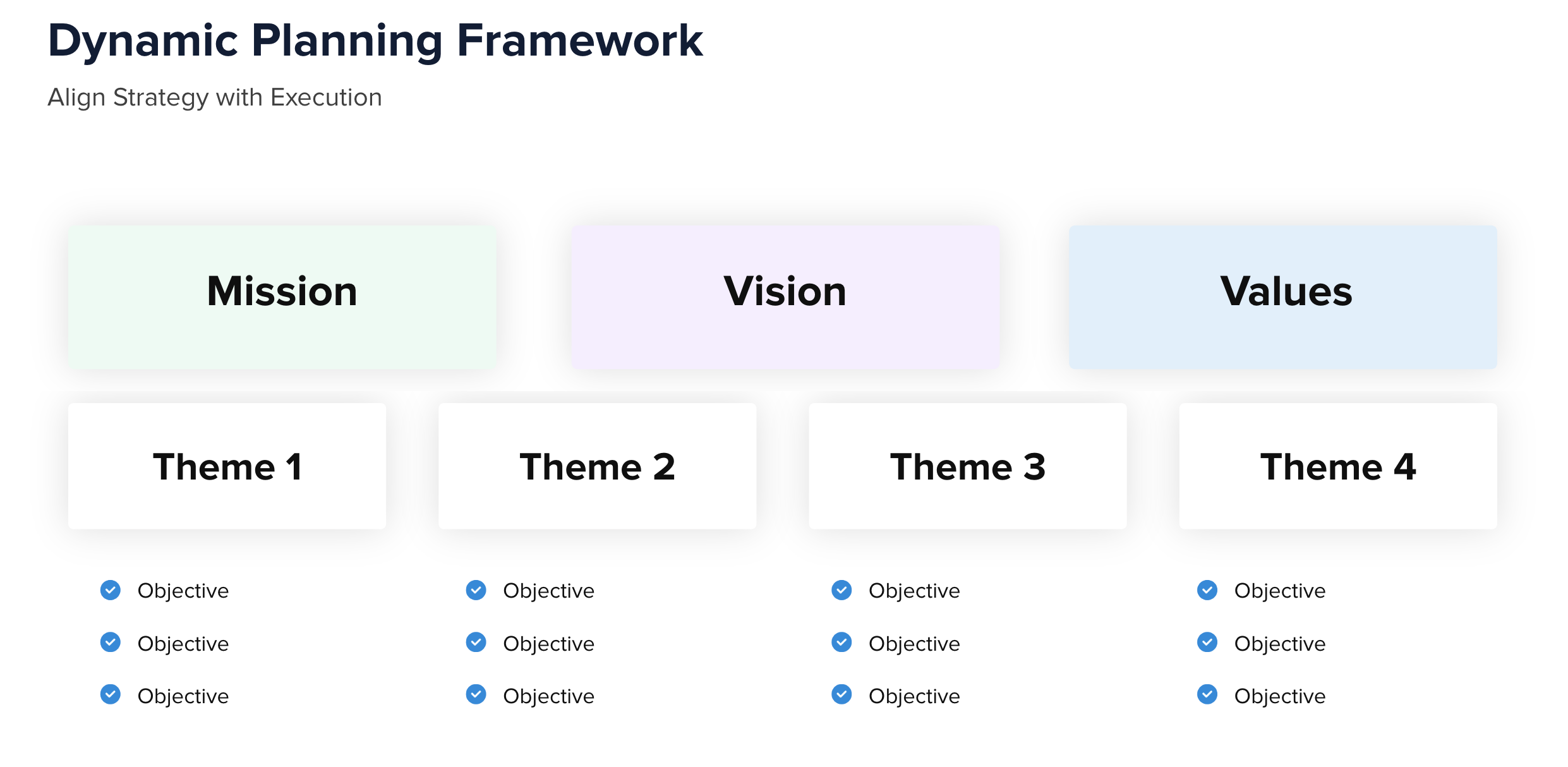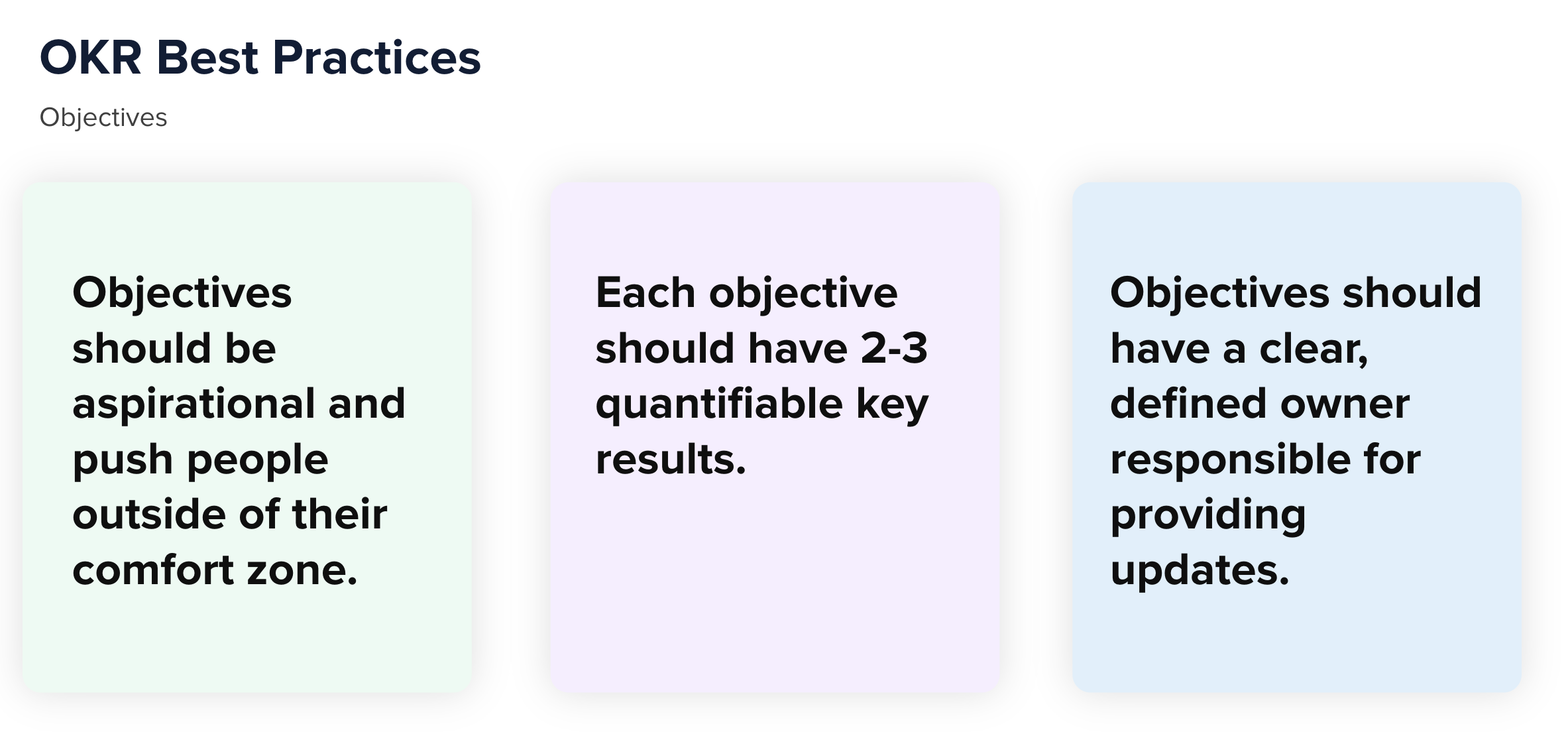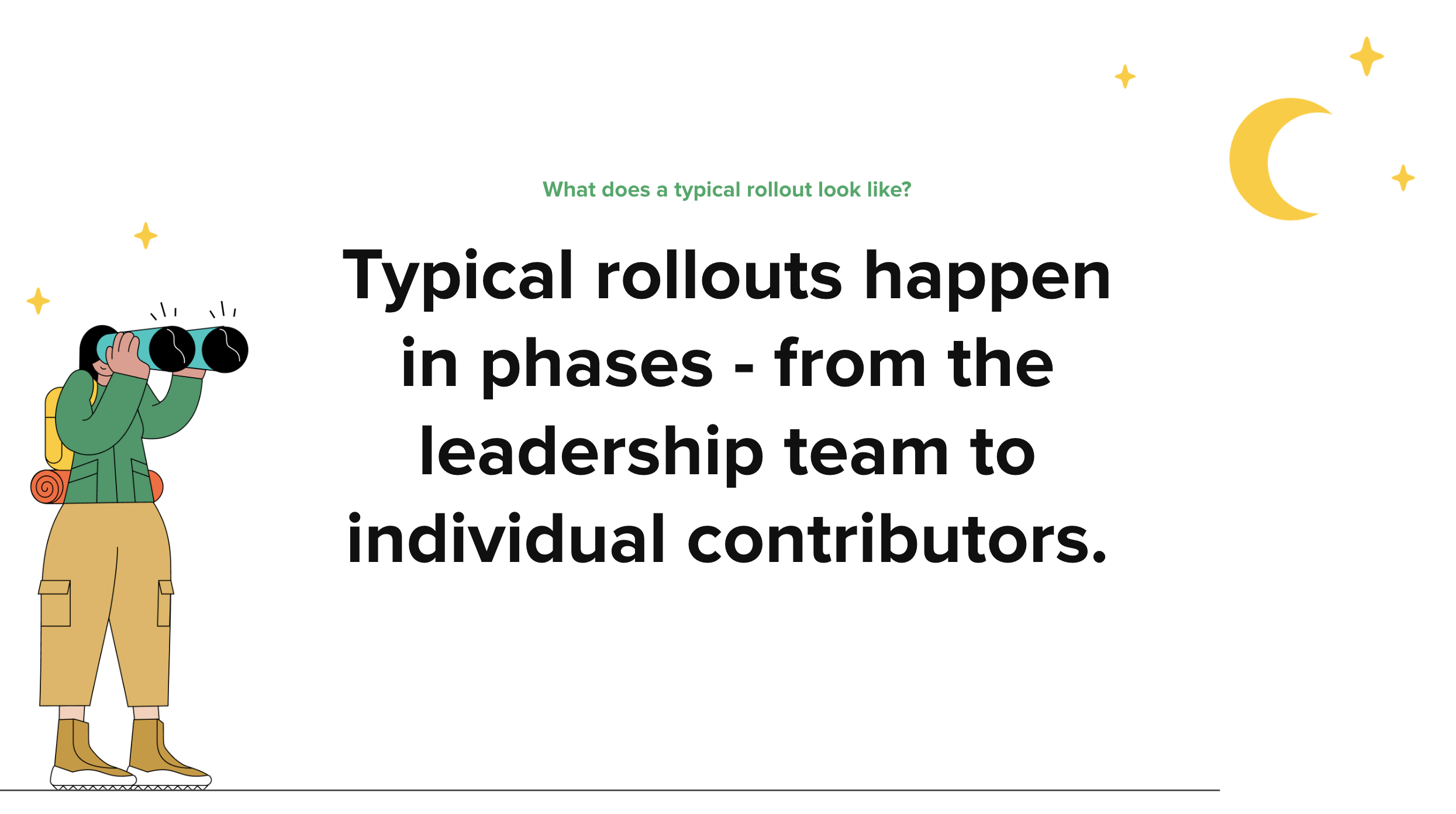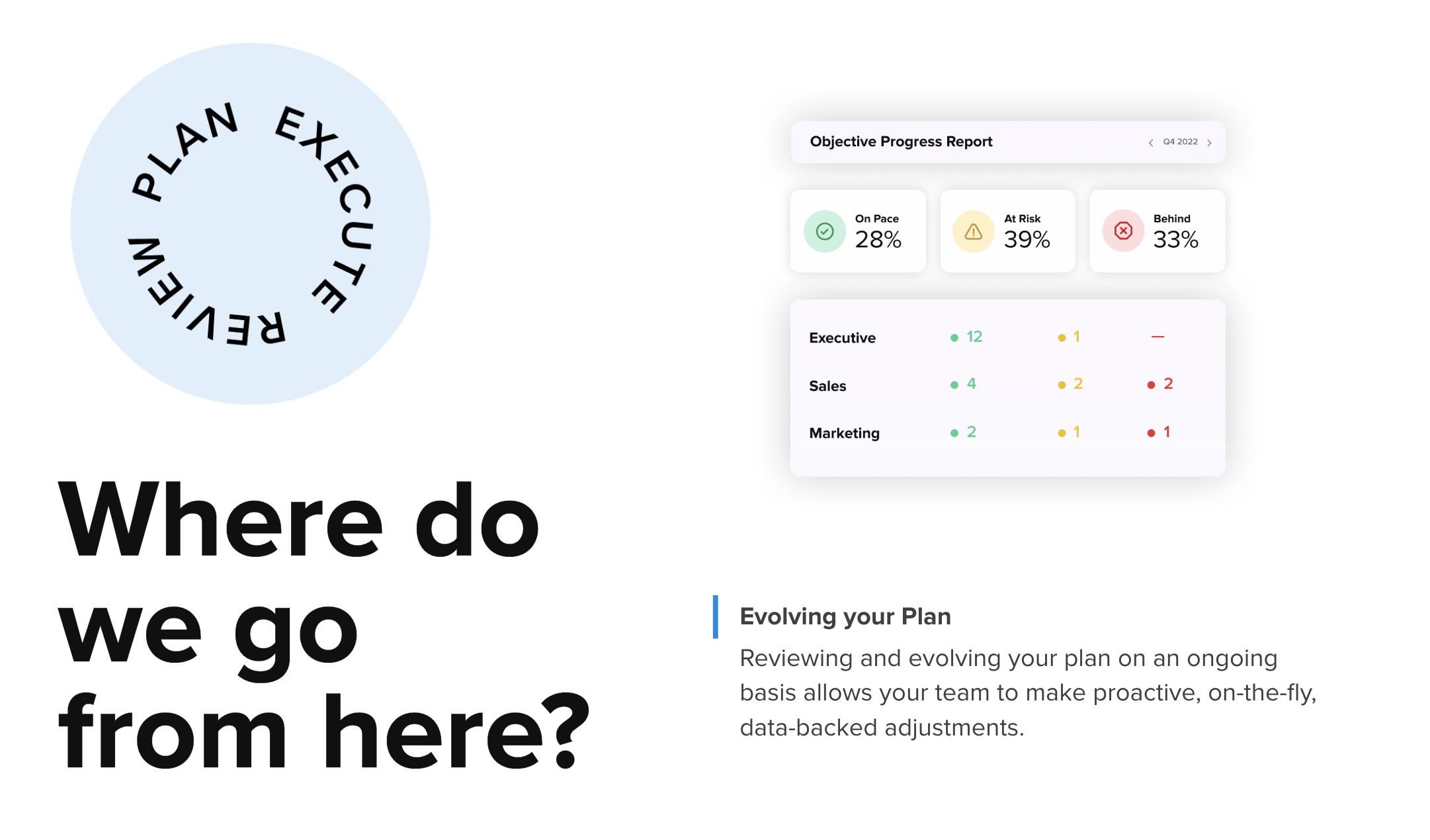
Today’s leading companies use Dynamic Planning to adapt to change, make better decisions, and move faster together.
For an overview how you can use Dynamic Planning to make execution a competitive advantage, check out our upcoming webinar 8 Ways to Amplify Your 2023 Strategic Plan.
For a comprehensive overview on how to Introduce Dynamic Planning to Your Company, we've written a 3 part series. Specifically, the articles included in this 3 part series are:
- Building the Case for Dynamic Planning
- Elevating from Traditional Planning to Dynamic Planning
- The Role of Strategy and Operations in Dynamic Planning (coming soon)
If you’d like to connect with our team to learn more about how Elate is partnering alongside leading Strategy and Operations teams to make the transition from Traditional Planning to Dynamic Planning, reach out to us today!
Elevate from Traditional Planning to Dynamic Planning
Welcome back to Part Two of our Three-Part Series on Introducing Dynamic Planning to Your Company. In Part One, we covered Building the Case for Dynamic Planning, outlining how Dynamic Planning can serve as a competitive advantage and the impact it can have on your organization.
In Part Two, we will be taking the next step in our Dynamic Planning journey by sharing how companies can successfully make the transition and elevate from Traditional Planning to Dynamic Planning. From the first step of rolling out your Dynamic Plan to the process of evolving how you Build, Execute, and Review your Strategy, Part Two of our series helps bring your Dynamic Planning strategy to life.
Building Your Dynamic Plan
To begin the transition from traditional Planning to Dynamic Planning, we turn our attention to the construction of our strategy. As discussed in Part One, we believe alignment starts at the top, as does the strategic direction of the organization.
However, for Strategy and Operations Leaders, the process of planning doesn’t stop at the Leadership level. Just as important as the strategy itself is the way that we connect the long-term direction with tactical execution.

When thinking of how this comes to fruition, we need to answer the following three questions to successfully connect strategy with tactical execution:
- What is our long-term direction? (3, 5, or 10-year horizon)
- What are we doing this year to help us get there, and what does a successful year look like? (one year horizon)
- How do we make that happen across teams? (Quarterly, Monthly, or Weekly horizon)
Building Blocks of a Dynamic Strategic Plan
To answer these three questions and to connect strategy and execution, there are some key building blocks that must be thought through. At Elate, we define the building blocks of a Dynamic Strategic Plan as the following:
- Company Mission, Vision, Values: Not only do these help provide direction to employees, but they should help set the course for the long-term direction of the company. They provide the lens through which we evaluate priorities and decisions made yearly, quarterly, and daily.
- Company Themes: If your Mission, Vision, and Values set the long-term direction, Themes should be the bridge between tactical execution and strategic vision. Themes often serve as the annual rallying cries helping to serve as the foundation for how we set quarterly objectives, track monthly metrics, and prioritize the initiatives that matter most to us as a business.
- Department, Team, and Individual Objectives: So how do we execute our plan and ensure team members understand how their work is connected to the company’s strategy? Objectives. From Departments, Teams and Individuals, Objectives serve as the way to ensure we aren’t driven by outputs, but rather, outcomes.
- Establish Rituals: Create a cadence for how your team provides updates, how they review updates, and how they clearly communicate the outcome of Objectives.
So what do these building blocks look like in practice? How do we take this framework and allow it to serve as the blueprint for how we build our Dynamic Plan? Let’s start by mapping out the framework in a visual:

Mission, Vision, and Values
As you can see, the overall Mission, Vision, and Values should serve as true north for the company. However, they aren’t just phrases to place on a wall or include on a company values page. They should serve as the means for how we prioritize the areas of focus we have as a company.
Themes
Underneath our Mission, Vision, and Values are the Themes that help indicate what ‘success’ will look like in the coming year. These Themes should align with the long-term direction of the company, and often represent the message Leadership is communicating to a Board of Directors for what the company is setting out to achieve in the coming year. Further, these Themes often serve as guidance for how quarterly Objectives should be categorized and prioritized.
One benefit of setting Themes that are supported by Objectives is understanding the amount of initiatives and projects owned by team members to accomplish these annual goals. Often, companies don’t know the number of Objectives supporting annual goals. Further, they don’t always realize if a theme is lacking support which can lead to missed goals and a lack of prioritization across teams.
Another benefit of setting annual Themes is that it gives clear direction to employees, aligning them on the priorities that matter most to the organization. Unlike narrow or overly-specific company targets, Themes give employees flexibility in pursuing opportunities that may overlap with other team members or potentially span multiple teams. Themes provide direction without being overly-prescriptive.
Typically, Themes should be defined first at the Leadership Level, and then communicated with the Management level of an organization. This phased rollout helps start the process of setting quarterly Objectives.
Objectives
At Elate, we refer to these quarterly goals as OKRs. However, your company may refer to them as Rocks, Goals, Project, or another term. Regardless of the terminology used by your company, Objectives serve as the bridge between your company’s annual Themes, and the quarterly initiatives driving the execution of your annual strategic plan.
So what is an OKR? It is defined as the following:

There might be hesitancy to embrace OKRs or any other goal-setting framework. Far too often, companies follow these frameworks to the letter of the law, which causes more headaches than benefits for employees.
As you evaluate potential frameworks, we encourage any company to first think about ‘why’ they are looking to introduce the process. The ‘how’ is critical to success, but if there isn’t agreement on the ‘why,’ then there will be a lack of buy-in. Don’t overcomplicate the process if you are just introducing it to the company. Start simple, and build on your process over time.
Finally, whether you are leveraging OKRs, EOS, 4DX, or any other framework, keep in mind that it should be tailored towards your organization. There are certainly key principles that guide your path, but don’t allow perfection to be the enemy of good.
As an example, here are a few key principles to keep in mind that can help set the stage for success.

Once you and your team have settled on a potential framework, we can now start to add structure to support it throughout the business.
For this process, we recommend Relationship Mapping. This is the process of aligning your strategy top-down and bottom-up, as well as across different teams. To properly structure your Relationship Mapping, we recommend connecting every Objective in a Parent/Child structure. Additionally, every Objective should be tied to an annual Theme. Below is an example of Relationship Mapping across Objectives:

The value of building Relationships across Objectives cannot be overstated. This is often the key to unlocking Dynamic Planning throughout your organization.
In creating Relationships that map across teams, as well as vertically from Leadership to Individual Contributors, Strategy and Operations Leaders can now create dependencies that alert them of when different Objectives are at risk or opportunities for growth arise.
One important piece to note is that this monitoring isn’t just for identifying problems or risks. When done right, Relationship Mapping will also surface Objectives that can serve as catalysts for unlocking new opportunities or accelerating your Strategic Plan.
In making the shift to Dynamic Planning, the building of your company’s plan is the foundation of long-term success. However, we can’t stop after we’ve built our plan. To achieve the alignment and transparency we are looking for, we must now roll out our plan across the company.
Rolling Out Your Dynamic Plan
After all of the time and effort to make the shift from Traditional Planning to Dynamic Planning, it’s crucial that your Strategic Plan doesn’t remain isolated at the Leadership level. In fact, communicating the direction for employees and ensuring their work is aligned to the strategic direction of the company is more important than ever before.
Far too many companies think the rollout takes place at an annual kickoff meeting. The truth is, the rollout of your Strategic Plan and the shift to a Dynamic Planning framework comes well before the new year begins.

While the starting point for creating your Dynamic Plan likely begins in your Leadership Offsite, there are a number of key steps that take place soon after. As we will discuss in Part Three: The Role of Strategy and Operations in Dynamic Planning, Strategy and Operations Leaders play a critical role in mapping out what comes next. While it might look a bit different for each company based on your organization’s size and stage, it should likely entail a phased approach.
With a phased approach, not only are you ensuring that you won’t be overwhelmed by the process or lose momentum, you also create an intuitive structure that employees can understand. Our high-level roadmap for a successful rollout includes the following steps:

Who Should Be Involved?
To successfully roll out the plan, first identify the appropriate team members with each phase of the process. We recommend you have the right team members for each of the phases:
- Phase 1: CEO & Founders: This includes the visionaries that set the mission, vision, & values that help drive the strategy forward.
- Phase 2 & 3: Executive Team: This team supports finalizing the company objectives & themes, and ensures they are aligned with the company strategy.
- Phase 4: Department Leads: This cohort will draft and collaborate on objectives that roll up to company objectives.
- Phase 5: Team Leads: This cohort will draft and collaborate on objectives that roll up to department objectives.
- Phase 6: Individual Contributors: Each employee will be aware of key initiatives and how each team contributes to the strategy.
In mapping out your Dynamic Plan rollout, you have now identified who will be involved, when they will be involved, and how you will be communicating your team’s strategic direction throughout the process.
When the company kickoff arrives, there will be no surprises for team members. Instead of a kickoff that only leads to more questions or uncertainty, with Dynamic Planning, your kickoff generates the momentum needed to tackle the new year!
Evolving Your Dynamic Planning Process
While it might feel like you are in the clear once you’ve built your Dynamic Plan and rolled it out to the rest of the organization, there is one more step to putting your new Strategic Planning process in place: Evolving Your Process.
One of the main differentiators of a Dynamic Planning process compared to the traditional planning approach is that it should scale with you. While traditional planning is static, reactive, and often outgrown by a company, Dynamic Planning should embrace the stage of your business and serve as a vehicle for continued growth.
The first part of evolving your plan is creating a cadence and rhythm for how your teams are reviewing the Dynamic Plan. We recommend two main forums: Team Meetings and All Hands Meetings.

By creating a regular cadence for how your team reviews the plan, it presents the opportunity to take action on the insights being surfaced in your Dynamic Plan. Unlike Traditional Planning that is only revisited on a quarterly basis, Dynamic Planning is regularly revisited, which allows you to make better decisions around potential risks and opportunities for growth.
Rather than letting these opportunities sit dormant, companies should embrace a regular meeting for discussing, debating, and taking action on what’s important.
Another benefit of a rhythm for reviewing your Dynamic Plan is the opportunity to identify areas of improvement. Some of the common areas we see surfaced include how companies transition quarters, modify Objectives, and hold team members accountable.

Ultimately, the evolution of your plan isn’t something that requires additional lift or effort. The beautiful part of Dynamic Planning is that it will come organically within your company’s regular operating framework. However, this does require discipline and buy-in across the Leadership team to set the tone that employees must regularly review their objectives.
While it may be challenging at the onset, committing to a process and embracing the change that will come with it will help you unlock Strategic Planning as a competitive advantage for your company.
The Future of Planning is Dynamic
By elevating your current strategy from Traditional Planning to Dynamic Planning, Strategy and Operations Leaders can directly impact the effective, sustainable growth of their company. At Elate, we believe this is made possible with three core pillars: People, Process, Solution.

Without all three components in mind as you make the transition to Dynamic Planning, you're bound to fail. Regardless of how hard you try with brute force to implement your new operating framework, it starts by bringing along the people, implementing a clear process, and allowing the framework to be amplified by a solution.
That’s where Elate comes in.

A solution like Elate can help create buy-In, streamline prioritization, and drive behavior change in a way that allows Dynamic Planning to come to life.
If you’re interested in learning more about Elate or wondering, ‘What’s next?’ in your Dynamic Planning journey, we’ve got you covered. Part Three of Elate’s series focuses on The Role of Strategy and Operations Leaders in Dynamic Planning.
For those interested in meeting with our team to learn more about how Elate is partnering alongside leading Strategy and Operations teams to make the transition from Traditional Planning to Dynamic Planning, reach out to us today! We’d love to partner alongside you to Unlock Your Strategy.


